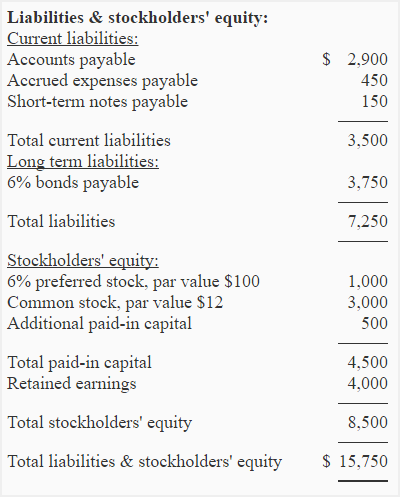How to Calculate the Debt to Equity Ratio
Debt to equity ratio (also termed as debt equity ratio) is a long term solvency ratio that indicates the soundness of long-term financial policies of a company. It shows the relation between the portion of assets financed by creditors and the portion of assets financed by stockholders. As the debt to equity ratio expresses the relationship between external equity (liabilities) and internal equity (stockholder's equity), it is also known as "external-internal equity ratio".
Formula:
Debt to equity ratio is calculated by dividing total liabilities by stockholder's equity.

The numerator consists of the total of current and long term liabilities and the denominator consists of the total stockholders' equity including preferred stock. Both the elements of the formula are obtained from company's balance sheet.
Example 1:
ABC company has applied for a loan. The lender of the loan requests you to compute the debt to equity ratio as a part of the long-term solvency test of the company.
The "Liabilities and Stockholders' Equity" section of the balance sheet of ABC company is given below:

Required: Compute debt to equity ratio of ABC company.
Solution:
Debt to equity ratio = Total liabilities/Stockholders' equity
= 7,250/8,500
= 0.85
The debt to equity ratio of ABC company is 0.85 or 0.85 : 1. It means the liabilities are 85% of stockholders equity or we can say that the creditors provide 85 cents for each dollar provided by stockholders to finance the assets.
A D V E R T I S E M E N T
Significance and interpretation:
A ratio of 1 (or 1 : 1) means that creditors and stockholders equally contribute to the assets of the business.
A less than 1 ratio indicates that the portion of assets provided by stockholders is greater than the portion of assets provided by creditors and a greater than 1 ratio indicates that the portion of assets provided by creditors is greater than the portion of assets provided by stockholders.
Creditors usually like a low debt to equity ratio because a low ratio (less than 1) is the indication of greater protection to their money. But stockholders like to get benefit from the funds provided by the creditors therefore they would like a high debt to equity ratio.
Debt equity ratio vary from industry to industry. Different norms have been developed for different industries. A ratio that is ideal for one industry may be worrisome for another industry. A ratio of 1 : 1 is normally considered satisfactory for most of the companies.
If debt to equity ratio and one of the other two equation elements is known, we can work out the third element. Consider the example 2 and 3.
Example 2 – computation of stockholders' equity when total liabilities and debt to equity ratio are given
The Petersen Trading Company has total liabilities of $937,500 and a debt to equity ratio of 1.25. Calculate total stockholders' equity of Petersen Trading Company.
Solution
Debt to equity ratio = Total liabilities/Total stockholder's equity
or
Total stockholder's equity = Total liabilities/Debt to equity ratio
= $937,500/1.25
= $750,000
Example 3 – computation of total liabilities when stockholders' equity and debt to equity ratio are given
The Steward Corporation's debt to equity ratio for the last year was 0.75 and stockholders' equity was $750,000. What was the total liabilities of the corporation?
Solution
Debt to equity ratio = Total liabilities/Total stockholder's equity
or
Total liabilities = Stockholders' equity × Debt to equity ratio
= $750,000 × 0.75
= $562,500
A D V E R T I S E M E N T
How to Calculate the Debt to Equity Ratio
Source: https://www.accountingformanagement.org/debt-to-equity-ratio/